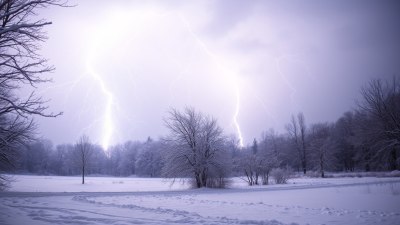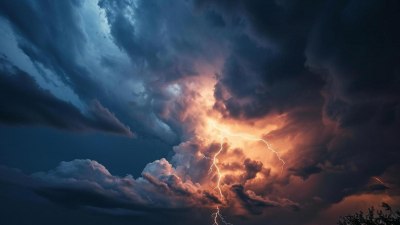Weather Myths You Still Believe and the Truth Behind Them
Uncover the truth behind popular weather myths and learn what science says about them.

This image was created with the assistance of Freepik
Weather myths have been a part of human culture for centuries, often passed down through generations. These beliefs can shape how we understand the world around us, but they are not always based on scientific truths. In this article, we will debunk some of the most common weather myths you might still believe and reveal the truth behind them.
Myth 1: Lightning Never Strikes the Same Place Twice
One of the most popular myths is that lightning never strikes the same place twice. This idea may provide some comfort, but the reality is quite different. Lightning can—and often does—strike the same place multiple times. In fact, tall structures such as skyscrapers and radio towers are frequently struck by lightning due to their height and metal composition. The Empire State Building, for example, is struck by lightning around 20 to 25 times each year. Scientists explain that lightning seeks the easiest pathway to the ground, making tall structures prime targets. Therefore, it is essential to seek shelter during thunderstorms, especially if you are near tall objects.
Myth 2: A Cold Winter Means a Hot Summer
Another common belief is that a cold winter will lead to a hot summer. This notion stems from the idea of seasonal patterns, but in reality, winter and summer temperatures are influenced by numerous complex factors. Climate systems are affected by various atmospheric conditions, solar output, and ocean currents. While some regions may experience a correlation between winter and summer temperatures, this is not a universal truth. Each season has its unique meteorological influences, and one cannot accurately predict the summer heat based solely on winter cold.
Myth 3: You Can Predict Rain by the Smell in the Air
Many people believe they can smell rain coming, attributed to the scent of ozone or petrichor. While this phenomenon may occur, it does not guarantee that rain will fall. The smell of impending rain is primarily caused by a compound called geosmin, released by soil-dwelling bacteria when wet conditions disrupt the ground. However, just because you smell rain doesn't mean it will actually rain. Understanding the weather requires looking at the clouds, air pressure, and temperature, rather than relying solely on scent.
Myth 4: If It's Cold, It Can't Snow
Some people think that cold temperatures mean no snow will fall. However, this is a misconception. Snow can occur at a wide range of temperatures, even in frigid conditions. Typically, snow forms when conditions are right and moisture is present in the atmosphere. As long as there is sufficient humidity, snow can fall regardless of the temperature, even if it's below freezing. In fact, some of the heaviest snowfalls occur during colder temperatures, such as during winter storms.
Myth 5: You Can Tell the Weather by Observing Animal Behavior
Many believe that animals can predict the weather, with certain behaviors indicating upcoming storms or changes in temperature. While animals might demonstrate unusual behavior before a storm—like seeking shelter or becoming agitated—this does not mean they possess an innate ability to forecast weather. Instead, animals are highly tuned to their environment and can sense changes in atmospheric pressure, which often precedes weather changes. While their behavior may reflect natural instincts, it cannot provide reliable weather predictions.
Myth 6: Windy Days Bring Rain
It’s often believed that windy days indicate that rain is on its way. Although strong winds can precede storms, it's not a definitive indicator of impending precipitation. Wind can blow in dry air, bringing clear skies instead. Wind patterns are influenced by differences in air pressure and temperature, leading to variable weather conditions. Therefore, while wind may indicate storm activity, it doesn’t guarantee rain; rather, it can lead to clearer or sunnier days as well.
Myth 7: It Rains More Before a Full Moon
Some people claim that rainfall increases as the full moon approaches. This belief ties back to ancient lore and the influence of lunar phases on natural events. However, scientific studies have shown no correlation between lunar phases and rainfall. Weather patterns are primarily driven by atmospheric conditions, not lunar cycles. While the moon’s gravitational pull affects tides in oceans and large bodies of water, it does not have a significant impact on the occurrence of rainfall.
Myth 8: More Clouds Mean It Will Rain
The presence of clouds can often lead us to assume that rain is imminent. However, not all clouds indicate precipitation. For instance, cumulus clouds are often fluffy and white, providing clear and sunny weather. Meanwhile, nimbus clouds are a sign of potential rain, but their presence doesn’t guarantee it will fall. The type and altitude of clouds are crucial indicators of weather conditions. To accurately judge whether rain may occur, one must also consider temperature, humidity, and air pressure.
Myth 9: The Weather Always Changes After a Big Snowstorm
It’s common for people to believe that once a significant snowstorm passes, the weather will clear and stabilize. While it is true that weather patterns often change after storms, they can also lead to further unstable conditions. Large snowstorms can alter air currents and pressure systems, potentially leading to cold snaps or lingering precipitation. Therefore, it's crucial to avoid assuming that the weather will calm down immediately after a big snowstorm; other weather systems could linger or develop.
Myth 10: Antarctica is the Coldest Place on Earth
When people think of extreme cold, Antarctica typically comes to mind. However, the coldest temperature ever recorded was not in Antarctica but in the Vostok Station, which had a record low of -128.6°F (-89.2°C) in July 1983. It’s essential to recognize that there are regions outside of Antarctica that can experience extreme low temperatures, such as the Siberian region of Russia, where temperatures can dip similarly low. This myth highlights the need to rely on factual climate data rather than assumptions based on geography.
Myth 11: Rain on a Wedding Day Is Bad Luck
In many cultures, it’s believed that rain on a wedding day signifies bad luck. This myth, however, has no basis in meteorological science or statistics. Instead, it’s worth noting that rain can symbolize renewal and fertility in various cultures, and some brides even believe that rain on their wedding day brings an opportunity for prosperity. So, while you may want sunny skies for your special day, a little rain might not be the omen some believe it is.
Myth 12: You Can’t Get Sunburned on a Cloudy Day
Many people fall into the misconception that cloudy weather means sunburns are impossible. However, UV rays can penetrate through clouds, and harmful rays can still reach our skin. Depending on the cloud cover, individuals can absorb significant UV radiation even on overcast days. It’s essential to continue using sunscreen regardless of weather conditions to protect against skin damage and related health risks.
Myth 13: It’s Safe to Stand Under a Tree During a Storm
Seeking shelter under a tree during a storm is a dangerous myth. Many assume that the tree will offer shelter from rainfall or lightning; however, trees are often struck by lightning due to their height. In fact, being under a tree can increase your chances of being struck. The safest course of action during a storm is to seek a fully enclosed building or a vehicle, far away from tall structures.
Myth 14: Snow is Cold
While snow is often associated with cold temperatures, it’s important to understand that snow itself is not cold; rather, it is made up of ice crystals created under specific temperature conditions. In fact, freshly fallen snow can insulate against cold air, causing the ground beneath it to remain warmer than exposed surfaces. This insulation effect can create a layer of warmth even in winter conditions, particularly when there is a significant snow cover.
Myth 15: A Clear Sky Means No Rain
It’s a common belief that a clear blue sky means that it will not rain. However, clear skies do not guarantee dry weather. Meteorological factors often dictate that changes can occur rapidly, leading to sudden precipitation even under a cloudless sky. Understanding that weather can be unpredictable is key to accurate forecasting. It’s recommended to check local forecasts regularly, as conditions can shift dramatically in a short time.
These weather myths reveal the complexities of human belief systems. While they can be entertaining, they can also lead to misunderstandings regarding weather patterns. By educating ourselves about the science behind weather phenomena rather than relying on outdated beliefs, we can better prepare for and understand the ever-changing nature of our environment. The next time you hear a weather myth, remember to look for the facts; it may just enhance your perspective on the world’s weather and its underlying science.











